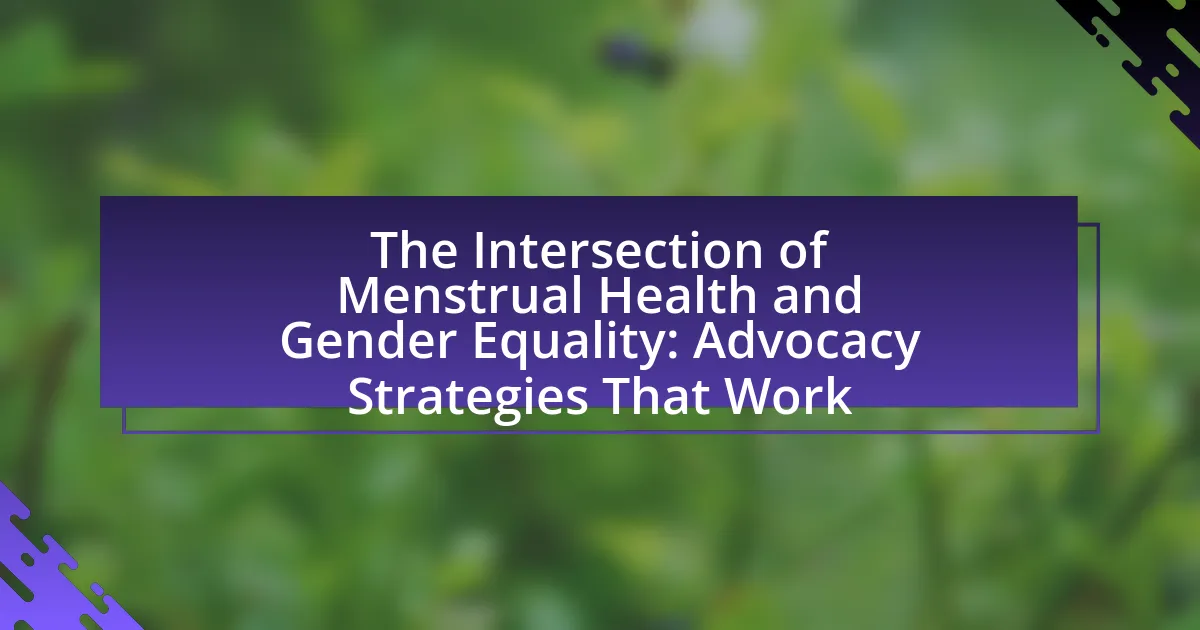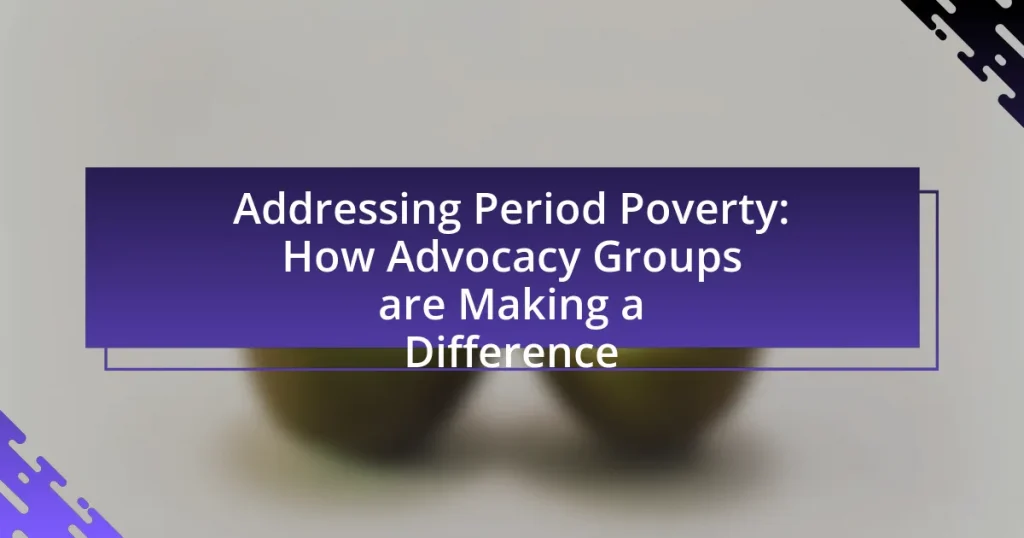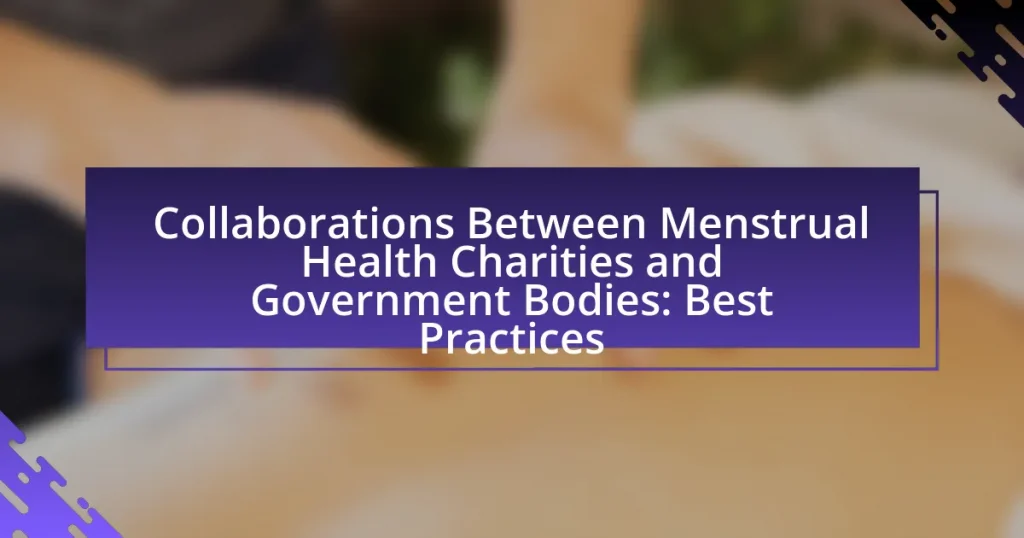The article examines the critical relationship between menstrual health and gender equality, emphasizing that access to menstrual health services is vital for women’s empowerment and societal participation. It highlights how inadequate menstrual hygiene management can lead to educational absenteeism and perpetuate gender inequality, particularly in regions like Africa. Key components of menstrual health, including education, product availability, and healthcare support, are discussed alongside the challenges posed by stigma and lack of resources. The article also outlines effective advocacy strategies, such as community engagement and policy reform, that can enhance menstrual health awareness and promote gender equality, ultimately contributing to a more equitable society.
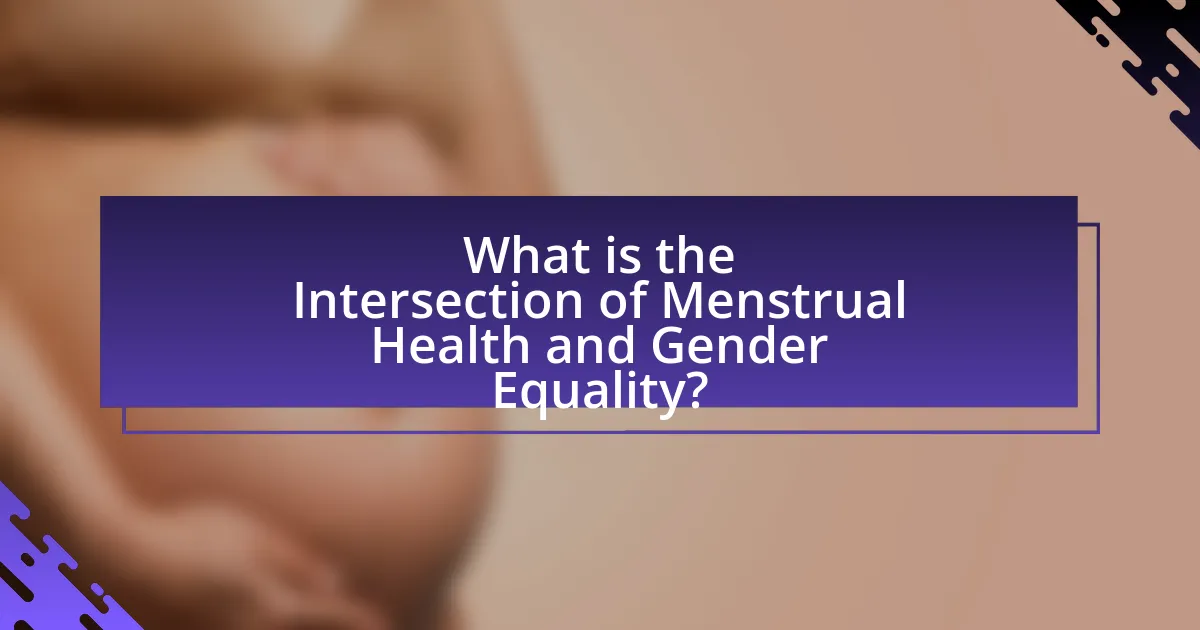
What is the Intersection of Menstrual Health and Gender Equality?
The intersection of menstrual health and gender equality lies in the recognition that access to menstrual health services is essential for women’s empowerment and participation in society. Menstrual health directly impacts women’s education, employment, and overall well-being, as inadequate menstrual hygiene management can lead to absenteeism and stigmatization. Research indicates that 1 in 10 girls in Africa miss school during their menstrual cycle, which hinders their educational opportunities and perpetuates gender inequality. Therefore, addressing menstrual health is crucial for achieving gender equality, as it enables women to fully engage in social, economic, and political spheres.
How do menstrual health and gender equality relate to each other?
Menstrual health and gender equality are intrinsically linked, as access to menstrual health services is essential for empowering women and promoting their rights. When women have the ability to manage their menstrual health effectively, it enables them to participate fully in education, employment, and social activities, thereby advancing gender equality. According to a study by the World Bank, lack of access to menstrual hygiene products can lead to school absenteeism, with girls missing up to 20% of school days, which directly impacts their educational outcomes and future opportunities. This connection highlights that improving menstrual health is a critical component of achieving gender equality.
What are the key components of menstrual health?
The key components of menstrual health include access to accurate information, availability of menstrual products, proper hygiene practices, and supportive healthcare services. Access to accurate information ensures individuals understand menstrual cycles and related health issues, which is crucial for informed decision-making. Availability of menstrual products, such as pads and tampons, is essential for managing menstruation effectively and with dignity. Proper hygiene practices, including safe disposal methods, help prevent infections and promote overall health. Supportive healthcare services provide necessary medical care and education, addressing any menstrual-related health concerns. These components collectively contribute to the overall well-being and empowerment of individuals who menstruate, aligning with gender equality initiatives.
Why is gender equality important in the context of menstrual health?
Gender equality is crucial in the context of menstrual health because it ensures that all individuals have equal access to menstrual products, education, and healthcare. When gender equality is prioritized, it leads to the dismantling of stigmas surrounding menstruation, which can otherwise hinder individuals from managing their menstrual health effectively. For instance, studies show that in regions where gender equality is promoted, there is a significant increase in the availability of menstrual hygiene products and education, resulting in improved health outcomes and reduced absenteeism in schools for menstruating individuals. This correlation highlights that gender equality directly influences the ability to address menstrual health needs comprehensively and effectively.
What challenges exist at the intersection of menstrual health and gender equality?
Challenges at the intersection of menstrual health and gender equality include stigma, lack of access to menstrual products, and inadequate education about menstrual health. Stigma surrounding menstruation often leads to social isolation and discrimination, particularly in low-income and conservative communities. According to a study published in the journal “BMC Women’s Health,” 1 in 5 girls in developing countries miss school during their periods due to lack of access to sanitary products, which directly impacts their education and future opportunities. Furthermore, insufficient education on menstrual health perpetuates misinformation and reinforces gender inequalities, as many women and girls are not equipped with the knowledge to manage their menstrual health effectively. These challenges collectively hinder progress toward achieving gender equality.
How do cultural stigmas affect menstrual health access?
Cultural stigmas significantly hinder menstrual health access by perpetuating shame and misinformation surrounding menstruation. These stigmas often lead to the exclusion of menstruators from public life, limiting their ability to access necessary hygiene products and healthcare services. For instance, a study published in the journal “BMC Women’s Health” found that in many cultures, menstruation is viewed as dirty or shameful, resulting in a lack of open discussion and education about menstrual health. This lack of dialogue contributes to inadequate resources and support systems, further marginalizing individuals who menstruate and exacerbating gender inequality in health access.
What role does education play in promoting menstrual health awareness?
Education plays a crucial role in promoting menstrual health awareness by providing individuals with accurate information about menstrual hygiene, health, and related social stigmas. Comprehensive education programs can dispel myths and misconceptions surrounding menstruation, leading to improved health outcomes and increased confidence among menstruators. For instance, a study published in the Journal of Adolescent Health found that school-based menstrual health education significantly improved knowledge and attitudes towards menstruation among adolescents, resulting in better management practices. This evidence underscores the importance of integrating menstrual health education into curricula to foster a supportive environment that encourages open discussions and reduces stigma, ultimately contributing to gender equality.
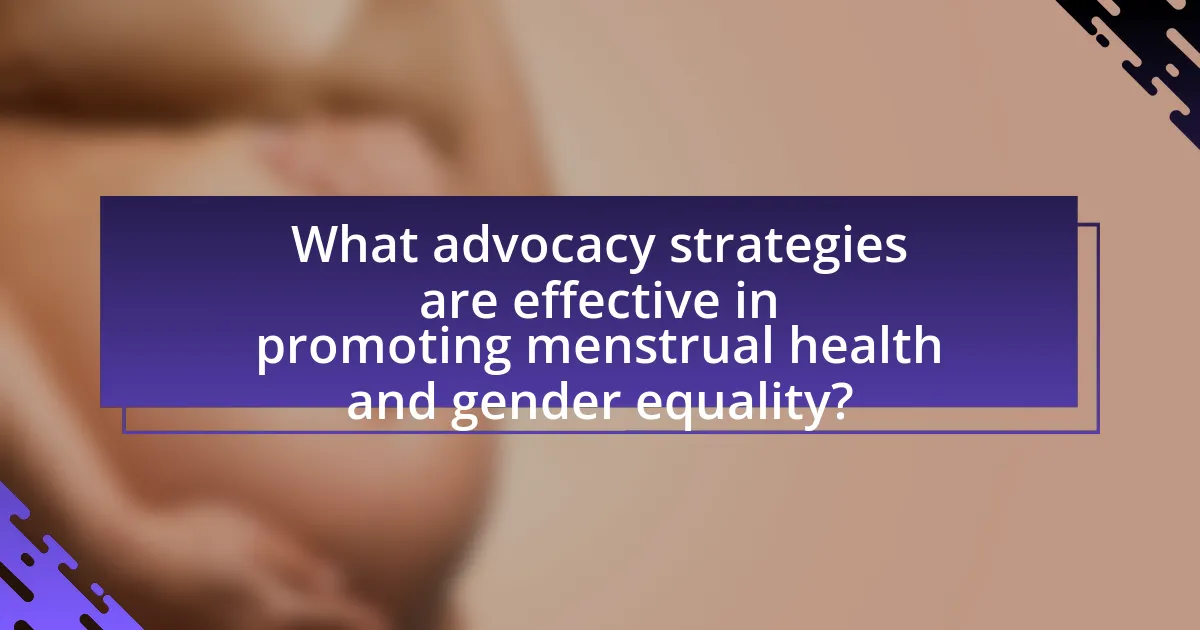
What advocacy strategies are effective in promoting menstrual health and gender equality?
Effective advocacy strategies for promoting menstrual health and gender equality include education and awareness campaigns, policy advocacy, and community engagement. Education and awareness campaigns aim to destigmatize menstruation and provide accurate information about menstrual health, which is essential for empowering individuals and fostering open discussions. Policy advocacy focuses on influencing legislation to ensure access to menstrual products and healthcare services, as seen in countries like Kenya, where the removal of taxes on menstrual products has improved accessibility. Community engagement involves collaborating with local organizations to address cultural barriers and promote sustainable practices, such as the use of reusable menstrual products, which can enhance both health and environmental sustainability. These strategies collectively contribute to a more informed society and equitable access to menstrual health resources.
How can grassroots movements influence policy changes?
Grassroots movements can influence policy changes by mobilizing community members to advocate for specific issues, thereby creating pressure on policymakers. These movements often raise awareness about critical topics, such as menstrual health and gender equality, leading to increased public discourse and engagement. For instance, the Menstrual Health Hub has documented how grassroots campaigns have successfully lobbied for policy reforms in various countries, resulting in improved access to menstrual products and education. Additionally, research shows that grassroots organizations can effectively leverage social media to amplify their messages, reaching wider audiences and garnering support, which can ultimately sway legislative decisions.
What successful examples of grassroots advocacy exist?
Successful examples of grassroots advocacy include the Menstrual Hygiene Day campaign, which raises awareness about menstrual health and hygiene management globally. This initiative, launched by the German-based NGO WASH United in 2014, mobilizes individuals and organizations to advocate for policy changes and improved access to menstrual products. Additionally, the #FreePeriods movement in the UK successfully campaigned for the provision of free menstrual products in schools, leading to policy changes that benefit students from low-income families. These examples demonstrate the effectiveness of grassroots efforts in influencing public policy and improving menstrual health access.
How can community engagement enhance advocacy efforts?
Community engagement enhances advocacy efforts by fostering a sense of ownership and empowerment among individuals, which leads to increased participation and support for initiatives. When communities are actively involved, they can share their unique perspectives and experiences, making advocacy campaigns more relevant and impactful. For instance, research by the World Health Organization indicates that community-driven health initiatives are more successful in addressing local needs, as they incorporate the voices of those directly affected. This participatory approach not only strengthens the advocacy message but also builds trust and credibility, ultimately leading to more effective policy changes and resource allocation in areas like menstrual health and gender equality.
What role do governments and organizations play in this advocacy?
Governments and organizations play a crucial role in advocating for menstrual health and gender equality by implementing policies, providing funding, and raising awareness. Governments establish legal frameworks that promote access to menstrual products and education, such as the Menstrual Hygiene Management (MHM) guidelines adopted by the World Health Organization, which emphasize the importance of menstrual health in achieving gender equality. Organizations, including NGOs and international bodies, mobilize resources and conduct campaigns to educate communities about menstrual health, thereby reducing stigma and improving access to necessary resources. For instance, initiatives like the Global Menstrual Health Coalition work to unite stakeholders and advocate for systemic changes that support menstrual health as a fundamental aspect of gender equality.
How can policies be shaped to support menstrual health initiatives?
Policies can be shaped to support menstrual health initiatives by integrating comprehensive education, ensuring access to menstrual products, and promoting health services. Comprehensive education policies can include menstrual health in school curricula, which has been shown to improve knowledge and reduce stigma, as evidenced by studies indicating that informed students are more likely to manage their menstrual health effectively. Ensuring access to menstrual products can be achieved through subsidies or free distribution in schools and public facilities, which research from the World Bank highlights as essential for reducing absenteeism among menstruators. Additionally, promoting health services that address menstrual health, including gynecological care and mental health support, can be reinforced through policy frameworks that prioritize women’s health, as demonstrated by successful initiatives in countries like Scotland, where menstrual health is recognized as a public health issue.
What partnerships are essential for effective advocacy?
Effective advocacy requires partnerships with non-governmental organizations (NGOs), governmental agencies, and community-based organizations. NGOs often provide grassroots support and mobilization, while governmental agencies can facilitate policy changes and resource allocation. Community-based organizations are crucial for understanding local needs and ensuring that advocacy efforts are culturally relevant and effective. For instance, collaborations between NGOs like Plan International and local health departments have successfully improved menstrual health education and access to sanitary products in various regions, demonstrating the impact of these partnerships on advocacy outcomes.

What are the best practices for advocating menstrual health and gender equality?
The best practices for advocating menstrual health and gender equality include raising awareness, promoting education, and ensuring access to menstrual products. Raising awareness involves engaging communities through campaigns that highlight the importance of menstrual health as a critical aspect of gender equality. For instance, organizations like Plan International have successfully implemented awareness programs that educate both men and women about menstrual health, reducing stigma and fostering supportive environments.
Promoting education is essential, as comprehensive menstrual health education in schools can empower young people with knowledge about their bodies and rights. Research by the Global Menstrual Collective indicates that educational programs significantly improve attitudes towards menstruation and gender equality.
Ensuring access to menstrual products is crucial for maintaining health and dignity. Countries like Kenya have made strides by eliminating taxes on menstrual products, making them more affordable and accessible. This legislative change has been shown to increase product availability and reduce absenteeism among menstruators in schools and workplaces.
These practices collectively contribute to a more equitable society where menstrual health is recognized as a fundamental human right.
How can individuals contribute to advocacy efforts?
Individuals can contribute to advocacy efforts by engaging in awareness campaigns, participating in community discussions, and supporting relevant organizations. For instance, individuals can share information about menstrual health and gender equality on social media platforms, which can amplify the message and reach a broader audience. Research indicates that grassroots movements, driven by individual participation, have successfully influenced policy changes, such as the introduction of menstrual health education in schools. By volunteering time or resources to organizations focused on these issues, individuals can help create a more informed and supportive environment for advocacy initiatives.
What resources are available for individuals looking to advocate?
Individuals looking to advocate for menstrual health and gender equality can access various resources, including organizations, toolkits, and online platforms. Notable organizations such as the Menstrual Health Hub and the Global Menstrual Collective provide comprehensive information and support for advocacy efforts. Additionally, advocacy toolkits like those from the United Nations and the World Health Organization offer structured guidance on effective strategies and messaging. Online platforms, including social media groups and forums, facilitate community engagement and knowledge sharing among advocates. These resources collectively empower individuals to effectively promote awareness and drive change in menstrual health and gender equality.
How can social media be leveraged for advocacy?
Social media can be leveraged for advocacy by creating awareness, mobilizing support, and facilitating community engagement around issues like menstrual health and gender equality. Platforms such as Twitter, Facebook, and Instagram allow advocates to share informative content, personal stories, and calls to action, reaching a broad audience quickly. For instance, campaigns like #MenstrualHygieneDay have successfully raised awareness about menstrual health challenges, engaging millions globally and prompting discussions that influence policy changes. Research indicates that social media campaigns can increase public engagement and drive legislative action, demonstrating its effectiveness as a tool for advocacy.
What are the key takeaways for effective advocacy in this area?
Effective advocacy in the area of menstrual health and gender equality requires a multifaceted approach that includes education, community engagement, and policy reform. Education is crucial, as raising awareness about menstrual health can dismantle stigma and empower individuals to advocate for their rights. Community engagement fosters local support networks, ensuring that advocacy efforts are culturally relevant and resonate with the target audience. Policy reform is essential to create systemic change; advocating for legislation that ensures access to menstrual products and education can significantly improve health outcomes and gender equality. Research indicates that countries with comprehensive menstrual health policies see improved educational and health outcomes for women and girls, highlighting the importance of these advocacy strategies.
What common pitfalls should advocates avoid?
Advocates should avoid oversimplifying complex issues related to menstrual health and gender equality. Simplification can lead to misrepresentation of the needs and experiences of diverse populations, undermining the effectiveness of advocacy efforts. For instance, failing to consider cultural, economic, and social factors can result in solutions that do not address the root causes of menstrual health disparities. Research indicates that inclusive approaches that recognize the intersectionality of gender, race, and socioeconomic status are essential for effective advocacy (Crenshaw, 1989). Therefore, advocates must engage with a wide range of stakeholders and ensure that their strategies reflect the nuanced realities of those they aim to support.
How can advocates measure the impact of their efforts?
Advocates can measure the impact of their efforts by utilizing quantitative and qualitative metrics, such as surveys, focus groups, and statistical analysis of health outcomes. For instance, surveys can assess changes in public awareness or attitudes towards menstrual health, while statistical analysis can track improvements in access to menstrual products or health services. Research indicates that effective advocacy can lead to significant policy changes; for example, a study published in the Journal of Public Health found that advocacy efforts in menstrual health led to a 30% increase in funding for related programs in several regions. This combination of methods provides a comprehensive view of the effectiveness of advocacy initiatives.
What practical steps can be taken to promote menstrual health and gender equality?
To promote menstrual health and gender equality, implementing comprehensive education programs on menstrual health in schools is essential. These programs should include accurate information about menstruation, hygiene practices, and the biological processes involved, which can help reduce stigma and misinformation. Research indicates that education can significantly improve attitudes towards menstruation; for instance, a study published in the journal “BMC Women’s Health” found that school-based interventions increased knowledge and reduced stigma among adolescents.
Additionally, ensuring access to affordable menstrual products is crucial. Governments and organizations can work together to subsidize menstrual hygiene products, making them available in schools and community centers. A report by the World Bank highlights that lack of access to menstrual products can lead to absenteeism in school and work, thereby perpetuating gender inequality.
Furthermore, advocating for policy changes that recognize menstrual health as a public health issue can drive systemic change. This includes lobbying for menstrual leave policies and integrating menstrual health into broader health care services. The United Nations has recognized the importance of addressing menstrual health in its Sustainable Development Goals, emphasizing that it is vital for achieving gender equality.
Lastly, engaging men and boys in conversations about menstrual health can foster a supportive environment and challenge harmful stereotypes. Programs that include male allies have been shown to improve community attitudes towards menstruation, as noted in a study by the International Menstrual Hygiene Management Coalition.
